Salvage logging, a practice aimed at boosting wood production through timber harvesting, has become increasingly prevalent in recent years. This controversial method involves the removal of trees that have been damaged by natural disasters such as wildfires, windstorms, or insect infestations. By salvaging these damaged trees before they decay or pose further risks to the forest ecosystem, salvage logging offers potential economic benefits while also mitigating environmental hazards. For instance, consider a hypothetical case study where a wildfire ravages a large forested area: implementing salvage logging could not only contribute to the local economy by providing valuable timber resources but also aid in restoring and regenerating the affected landscape.
Despite its potential advantages, salvage logging remains subject to intense debate within the scientific community and among stakeholders involved in forestry management. Proponents argue that this practice can help reduce financial losses associated with damaged forests and promote sustainable harvest practices. Additionally, it is believed that salvage logging can play a crucial role in preventing secondary ecological disturbances caused by decaying trees or pest outbreaks. However, critics express concerns about the long-term effects on biodiversity and habitat quality due to disturbance resulting from heavy machinery used during salvage operations. Moreover, questions arise regarding whether the economic gains outweigh any negative impacts on ecosystem resilience and recovery processes following natural disturbances.
The long-term effects of salvage logging on biodiversity and habitat quality are still not fully understood. Critics argue that the removal of damaged trees can disrupt forest ecosystems and lead to the loss of important wildlife habitats, as well as negatively impact soil nutrients and water retention capabilities. They raise concerns about the potential decline in species diversity, particularly those dependent on dead wood for nesting or food sources. The mechanical operations involved in salvage logging, such as the use of heavy machinery, can also cause further damage to the forest floor and understory vegetation.
Another concern is whether the economic gains from salvage logging outweigh any negative impacts on ecosystem resilience and recovery processes following natural disturbances. While salvage logging provides immediate economic benefits by utilizing damaged trees that would otherwise go to waste, some argue that these short-term gains may hinder long-term ecological recovery. Removing dead or dying trees can impede natural regeneration processes and delay the establishment of new tree communities.
It is important to note that opinions regarding salvage logging vary depending on regional context, forest type, and management objectives. Some studies have shown positive outcomes when implementing careful planning and monitoring during salvage operations, including reduced wildfire risks and enhanced timber production. However, additional research is needed to better understand the trade-offs associated with this practice and develop more comprehensive guidelines for sustainable salvage logging practices.
Ultimately, decisions regarding salvage logging should consider a balanced approach that takes into account both economic benefits and potential environmental consequences. Collaboration among stakeholders, including scientists, foresters, policymakers, and local communities, is crucial to ensure responsible forest management practices that promote both ecological integrity and socio-economic well-being.
What is Salvage Logging?
Salvage logging refers to the practice of harvesting trees from forests that have experienced natural or man-made disturbances, such as wildfires, windstorms, or insect infestations. This method aims to recover economic value from damaged or dying timber and mitigate potential risks associated with these disturbances. To illustrate its significance, let’s consider a hypothetical case study of a forest fire.
Imagine a large-scale wildfire has recently swept through a dense forest area, leaving behind charred and weakened trees. In this scenario, salvage logging would involve selectively removing the fire-damaged trees in order to prevent further spreading of pests and diseases while maximizing timber recovery. The objective is to restore ecological balance and promote the regeneration of healthy tree stands.
By implementing salvage logging practices, multiple benefits can be achieved:
- Economic Recovery: Salvaging valuable timber resources not only helps compensate for financial losses incurred by landowners but also contributes to local economies through wood production.
- Ecological Stabilization: Removing dead or deteriorating trees reduces fuel loads and minimizes the risk of future catastrophic fires. It allows for more efficient reforestation efforts and promotes biodiversity.
- Habitat Restoration: Salvage logging facilitates the restoration of wildlife habitats by creating open spaces and providing opportunities for new vegetation growth.
- Carbon Sequestration: Prompt removal of burned trees prevents carbon emissions resulting from decomposition processes. By salvaging usable timber products, long-term carbon storage can be maximized.
Table: Benefits Associated with Salvage Logging
| Benefit | Description |
|---|---|
| Economic Recovery | Compensation for financial losses; contribution to local economies |
| Ecological Stabilization | Reduction of fuel loads; prevention of future catastrophic fires |
| Habitat Restoration | Creation of open spaces; promotion of new vegetation growth |
| Carbon Sequestration | Prevention of carbon emissions; maximization of long-term carbon storage |
In summary, salvage logging plays a crucial role in recovering timber resources and mitigating risks following natural or man-made disturbances. By removing damaged trees, it not only supports economic recovery but also aids in ecological stabilization, habitat restoration, and carbon sequestration. These benefits highlight the significance of implementing salvage logging practices to ensure sustainable forest management.
Moving forward to the next section, let us explore the various advantages that arise from utilizing salvage logging techniques – “The Benefits of Salvage Logging.”
The Benefits of Salvage Logging
One example of the positive impacts of salvage logging can be seen in a case study conducted in a forested area affected by wildfire. In this scenario, after a severe fire had swept through the region, leaving behind vast areas of burned trees and vegetation, salvage logging was implemented to recover usable timber. By promptly harvesting and utilizing these fire-damaged trees, wood production was significantly boosted, leading to economic benefits for the local communities that rely on the forestry industry.
The benefits of salvage logging extend beyond just this specific case study. Here are some key ways in which salvage logging can positively impact wood production:
- Increased supply: Salvage logging allows for the utilization of trees that have already been damaged or killed due to natural disturbances like wildfires or insect infestations. By salvaging these trees before they deteriorate further, it helps maintain a steady supply of timber for various industries such as construction, furniture manufacturing, and paper production.
- Enhanced resource efficiency: Salvage logging ensures that damaged trees do not go to waste. Instead of allowing them to decompose naturally over time, their potential value is realized through timely extraction and processing. This approach maximizes resource efficiency by making use of otherwise lost or unusable timber resources.
- Reduced pressure on healthy forests: By focusing on salvaging dead or damaged trees, salvage logging reduces the need for extensive harvesting in healthy forests. This helps to minimize ecological disruption while meeting society’s demand for wood products.
- Socioeconomic benefits: The increased wood production resulting from salvage logging provides economic opportunities at both local and national levels. It supports jobs within the forestry sector, stimulates rural economies dependent on timber-related activities, and contributes to overall regional development.
These positive impacts highlight how salvage logging can play a crucial role in boosting wood production sustainably. However, it is important to recognize that there are also concerns associated with this practice.
Environmental Concerns of Salvage Logging
Building upon the benefits of salvage logging, it is crucial to acknowledge and address the environmental concerns associated with this practice. By examining these concerns, we can gain a comprehensive understanding of the complex implications of salvage logging on ecosystems.
While salvage logging offers numerous advantages, including economic opportunities and reduced fuel loads in fire-prone areas, its potential negative impacts cannot be ignored. One hypothetical scenario that highlights these concerns involves an area affected by a severe wildfire. After the fire has swept through, timber companies rush to extract as much usable wood as possible before decomposition sets in. However, this sense of urgency may lead to inadequate assessment of ecological factors and hasty decision-making regarding which trees should be harvested.
To fully comprehend the environmental challenges associated with salvage logging, it is essential to consider both short-term and long-term repercussions. Here are some key concerns:
- Habitat Disruption: Salvage logging often requires heavy machinery and equipment to access fire-damaged sites. This process can result in soil compaction, alteration of water drainage patterns, and destruction or fragmentation of critical wildlife habitats.
- Erosion and Sedimentation: The removal of vegetation cover through salvage logging exposes the forest floor to increased erosion risks during rainfall events. Consequently, excessive sediment runoff into nearby streams can negatively impact aquatic ecosystems.
- Regeneration Difficulties: Rapidly implemented salvaging operations may hinder natural regeneration processes by removing seed sources or disrupting natural seed dispersal mechanisms.
- Loss of Biodiversity: Targeting only commercially valuable tree species during harvesting neglects the importance of maintaining biodiversity within forests.
To further illustrate these concerns visually:
| Environmental Concerns | Implications |
|---|---|
| Habitat disruption | Fragmented ecosystems |
| Erosion and sedimentation | Degraded water quality |
| Regeneration difficulties | Delayed ecosystem recovery |
| Loss of biodiversity | Negative impact on ecosystem resilience |
In light of these potential consequences, it is clear that careful planning and implementation are necessary to mitigate the environmental risks associated with salvage logging. Regulations and guidelines play a crucial role in striking a balance between wood production and ecological preservation.
Understanding the importance of responsible salvage logging practices, let us now explore the existing regulations and guidelines governing this industry to ensure sustainable utilization of fire-damaged timber resources.
Regulations and Guidelines for Salvage Logging
Salvage logging, despite its potential benefits in boosting wood production, raises significant environmental concerns. One example that highlights these concerns is the aftermath of a large-scale wildfire in a forested area. The decision to conduct salvage logging after such an event can have long-lasting effects on the ecosystem.
Firstly, one major concern with salvage logging is its impact on biodiversity. The removal of fire-damaged trees through timber harvesting disrupts natural habitats and reduces the availability of resources for various species. This disruption can lead to declines in population sizes or even local extinctions of sensitive plant and animal species.
Secondly, salvage logging often involves heavy machinery and equipment that can cause soil compaction and erosion. These processes further degrade the already fragile post-fire landscape. Compacted soils limit water infiltration and nutrient cycling, negatively affecting vegetation regeneration and overall ecosystem recovery.
Lastly, salvage logging can also alter hydrological dynamics by removing canopy cover, which increases evaporation rates and alters runoff patterns. This change in water flow affects downstream ecosystems, including aquatic habitats and their associated flora and fauna.
The environmental concerns surrounding salvage logging are not limited to these examples but extend beyond them as well. To better understand the implications of this practice, it is essential to consider regulations and guidelines that govern salvage logging activities. These measures aim to strike a balance between economic interests and ecological preservation while mitigating potential negative impacts on the environment.
- Destruction of wildlife habitat
- Soil compaction and erosion
- Altered hydrological dynamics
- Disruption of ecosystem functioning
| Environmental Concerns | Examples |
|---|---|
| Biodiversity loss | Sensitive plant & animal species facing decline or extinction |
| Soil degradation | Compaction, erosion limiting regeneration & nutrient cycling |
| Hydrological changes | Increased evaporation rates & altered runoff patterns |
As we delve into the regulations and guidelines for salvage logging in the subsequent section, it becomes evident that addressing these environmental concerns is crucial to ensure sustainable forest management practices. The next section will shed light on these measures while exploring their effectiveness in safeguarding both economic interests and ecological integrity.
Moving forward, we will now examine the economic impact of salvage logging without compromising environmental considerations.
Economic Impact of Salvage Logging
To fully understand the implications of salvage logging, it is crucial to examine its environmental impact. Through the removal of damaged or dead trees after natural disturbances such as wildfires or storms, salvage logging aims to optimize wood production while mitigating potential ecological consequences. In this section, we will explore the environmental effects associated with salvage logging and consider both its benefits and drawbacks.
Case Study: The Effects of Salvage Logging on Biodiversity
One example that sheds light on the environmental impact of salvage logging is a case study conducted in a fire-damaged forest ecosystem. Researchers found that post-fire salvage logging significantly altered species composition and reduced overall biodiversity compared to areas left untouched. This disruption resulted from the disturbance caused by heavy machinery during timber extraction and subsequent loss of habitat heterogeneity.
Environmental Consequences:
- Habitat Fragmentation: The practice of salvage logging can lead to increased fragmentation of habitats due to road construction and tree removal, which may further isolate populations and limit gene flow among organisms.
- Soil Erosion: Removal of trees destabilizes slopes, increasing the risk of soil erosion. Without adequate vegetation cover, rainfall washes away topsoil, leading to diminished soil fertility and water quality.
- Disruption of Natural Succession: By removing dead trees prematurely, salvage logging disrupts natural succession processes necessary for regrowth and regeneration within an ecosystem.
- Impacts on Wildlife: Salvage logging activities can directly affect wildlife through direct mortality or displacement from their habitats. Additionally, changes in vegetation structure following timber extraction may alter food availability and nesting opportunities.
Table – Potential Environmental Consequences:
| Environmental Consequence | Description |
|---|---|
| Habitat Fragmentation | Increased isolation between populations due to road construction and tree removal |
| Soil Erosion | Destabilization of slopes leading to soil erosion, decreased fertility, and compromised water quality |
| Disruption of Natural Succession | Interferes with the natural regrowth and regeneration processes within an ecosystem |
| Impacts on Wildlife | Direct mortality or displacement of wildlife due to salvage logging activities; changes in vegetation structure affecting food availability |
Future Trends in Salvage Logging:
As we look ahead, it is essential to consider potential advancements and innovations that may shape the future of salvage logging. By exploring sustainable practices, such as selective harvesting techniques and reforestation efforts, we can aim to minimize environmental impacts while still meeting timber production needs. In the following section, we will delve into these future trends and their implications for salvage logging.
Please let me know if you need any further assistance!
Future Trends in Salvage Logging
Transition from Previous Section H2:
Having examined the economic impact of salvage logging, we now turn our attention to the future trends in this practice. As timber harvesting continues to be a vital aspect of wood production, it is crucial to explore how salvage logging can further boost productivity while considering its potential environmental consequences.
Section: Future Trends in Salvage Logging
The potential for increased wood production through salvage logging is evident when we consider its application in various contexts. For instance, let us examine a hypothetical scenario where a severe wildfire has swept through a forested area, leaving behind vast expanses of burnt trees. In such cases, salvage logging can play a crucial role in mitigating losses and promoting regeneration.
To fully understand the future trends in salvage logging, it is essential to highlight some key factors that will shape this practice:
- Technological advancements: With ongoing developments in forestry technology, tools and machinery used in salvage logging are becoming more efficient and environmentally friendly.
- Sustainable forest management practices: There is an increasing emphasis on sustainable forest management, which includes integrating salvage logging into overall ecosystem restoration plans.
- Collaborative approaches: Stakeholder engagement and collaboration among government agencies, industry representatives, and environmental organizations will become increasingly important for ensuring balanced decision-making regarding salvage logging initiatives.
- Climate change adaptation: As climate change continues to pose challenges for forests worldwide, strategies incorporating salvage logging may offer opportunities to adapt forests to changing conditions effectively.
Emotional Bullet Point List
- Increased efficiency leading to reduced waste
- Restoration of fire-damaged ecosystems
- Job creation and economic benefits for local communities
- Enhanced biodiversity conservation efforts
Emotional Table
| Factors | Benefits | Challenges |
|---|---|---|
| Technology Advancements | – Improved efficiency- Reduced ecological impact | – Initial investment costs- Training requirements |
| Sustainable Forest Management Practices | – Ecosystem restoration- Regeneration of forest stands | – Balancing economic and environmental concerns- Long-term monitoring |
| Collaborative Approaches | – Inclusive decision-making process- Consideration of multiple perspectives | – Potential conflicts of interest- Time-consuming negotiations |
| Climate Change Adaptation | – Increased resilience of forests- Improved carbon sequestration | – Uncertainty in predicting future conditions- Need for adaptive management strategies |
In summary, the future trends in salvage logging hold promise for boosting wood production while addressing ecological concerns. Technological advancements, sustainable forest management practices, collaborative approaches, and climate change adaptation will shape this practice moving forward. By considering these factors and engaging various stakeholders, we can ensure that salvage logging contributes to both economic prosperity and environmental sustainability.

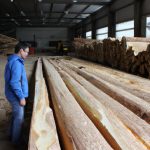

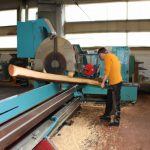



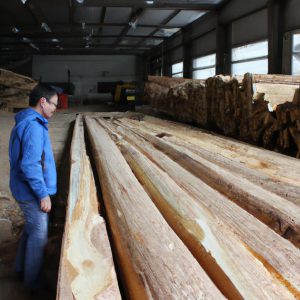

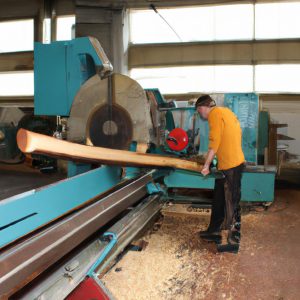
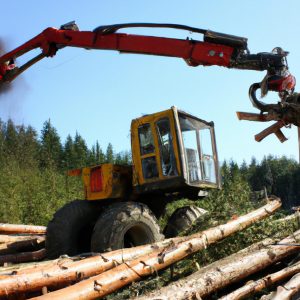
More Stories
Timber Harvesting for Wood Production: An Informative Overview
Logging Methods for Timber Harvesting: Maximizing Wood Production
Timber Extraction: Wood Production and Timber Harvesting